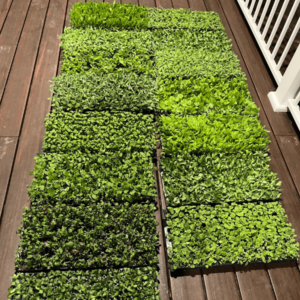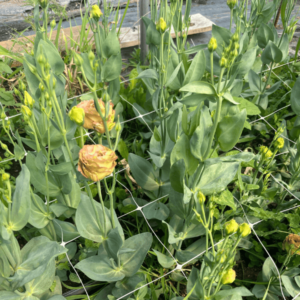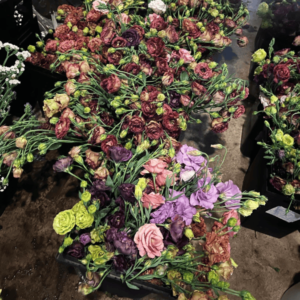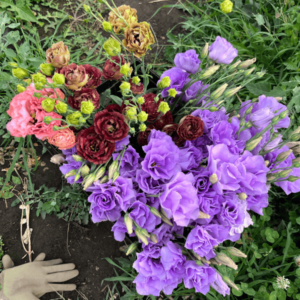
Welcome back to another Sunny Mary Meadow podcast/blog post. I am your host Liz Fiedler. The day this was recorded/written was August 22, 2023, and in full transparency, I think we’ve recorded one episode since early June prior to this. That was the dahlia episodes/posts we’ve shared over the past couple of weeks. There have been a few bonus Bloom & Grow episodes of the podcast that we have released here and there, but most of the growing episodes were done significantly earlier in the season before the season really kicked off because we knew we were going to be so incredibly busy with flower season and we were not going to be want to be inside recording episodes.

So today, I am going to talk about lisianthus. The reason I didn’t have this on my list of episodes to record last spring or earlier this summer is that I hadn’t really grown them before, so I really didn’t think I should talk about it. For the ranunculus, I did a before and after episode, where I recorded what I was going to do last spring, and then in June, I recorded what actually happened and how they turned out. I guess I maybe could have done that with this, too, but I didn’t think they were going to be that big of a deal. However, I found out they’re definitely an undertaking.
I guess I shouldn’t say I’ve never grown them before. The last time, I bought four 4-packs (so 16 plants), and one died immediately. So, I had 15 plants the very first year I had the farmstand, and I know that I got a second flush out of them. I remember that I didn’t stake them, yet somehow, they did okay that year. I think I just ultimately got pretty lucky. I bought them from a greenhouse, and they were quite established by the time I bought them. So yeah, I definitely got lucky.
So now, this year, I did quite a bit of research before I grew them. I’ve been watching other growers, and I knew I wanted to do it big. Again, I don’t do anything small, so I had like 1600 plants. I think it was maybe five or six trays. No, it was six initially, and then I added two more, so eight trays and each tray has 210 plants. So that’s 16,680 lisianthus plants that I planted this year.
They kind of look like roses. I describe them as kind of thornless garden roses. I did a little bit of Googling about the history of them, and ultimately, they weren’t really used until about the 1990s in the United States, so there are a lot of people who don’t even know what they look like. They are an expensive premium flower, and that’s why you don’t see them very often. They’re also very difficult to buy via wholesale consistently. I bought some wholesale in April to use in my brother’s girlfriend’s prom flowers, and quite frankly, I was a little disappointed. I was disappointed because they have so many buds, and how you really should grow them properly is you disbud the very first flower, and then the rest of them open. Well, on these basically the first bud had opened and then the rest were completely closed, and that’s how they were sold. They grow them on-site, so they probably cut them on demand, or I guess I don’t know for sure how exactly it works. But overall, the quality of locally grown lisianthus I have been far more impressed with.

I just love them, and they have an excellent vase life. They come in such a variety of colors, they’re so eye-catching, they really fill out bouquets, they’re excellent in groups, and I absolutely adore them. In the future, I’m going to plant so many more. Again, I’m in Zone 4B just outside of St. Cloud, Minnesota (St. Joseph). Growing them in this climate is a little bit more difficult or a little bit different … we’re much farther north than most people who grow them.
They do tolerate heat very well and they form a deep root. So, that means they need access to water, and they do want their roots to be cool. So, it’s not a good idea to plant them very late into June, when the soil starts getting pretty warm, and that’s hard because I grow them in a high tunnel. I grow them in a high tunnel for a few reasons. First of all, the wind just wreaks havoc on them. You definitely need two rows of support netting, which I’ll talk about in a little bit. Another reason I grew them in a high tunnel was that after talking to a lot of people in the area who have grown them before, I learned that one big rainstorm, especially when they’re just starting to open up and bloom, can really knock them down. Their flowers are just like a bowl or a cup, and they hold water. I just didn’t want to risk breaking off those stems between the wind and the rain. They’re such an expensive crop because I buy them as plugs, so I decided to grow them in the high tunnel.

In the spring, one side of my high tunnel had tulips in it, and the other half had my ranunculus. Once the tulips were done blooming, that’s where I planted all of the lisianthus. I’m going to have a second high tunnel built this fall, and that’s going to be huge in what I’m planning to do with the lisianthus and how I’m going to rotate all of those crops. After having grown them the way I did this year, I definitely would not grow them without a high tunnel, and they need two layers of support netting. I definitely will always, always, always order plugs.
Even resources like Lisa Mason Ziegler, who has The Gardener’s Workshop, says to buy plugs. Lisa is huge on Facebook, she’s written books, and she has workshops on growing and selling cut flowers. So, if Lisa Mason Ziegler is saying it, there’s something behind it. Of course, Farmer Bailey is going to tell you to buy plugs because he sells plugs. But ultimately, if growing from seed, they take like three to four months straight of babying them. They cannot completely dry out & you really have to watch them. They’re in such small cell trays that if you’re gone for three or four days, it doesn’t work. You have to literally babysit them. I like to go on vacations, I like to leave even if vacation means just going to my parents’ house for a little while. Usually, in the spring, like in February or March, I try to go down to my aunt and uncle’s in Arizona for an extended weekend. Or I try to go visit friends right before our flower season is going to start … so I just don’t want to have to baby seedlings. So that’s why that’s one of the reasons that I do plugs. If you’re growing them from seed, you can damage a whole tray really quickly by not keeping on track of watering them. So that’s why I buy them as plugs. Farmer Bailey is where I bought them this year, but I do have some things in the works for coming up with an alternative option for those wanting to grow them who are in Minnesota, but we’ll see. I have a phone call at 11:00 am today (Aug 22) with someone to talk about that. More to come on that … maybe … possibly.

So, I got them as plugs, and I believe mine came on May 8th. Next year, I’m going to have them come a little bit earlier, maybe a couple of weeks earlier, because they can tolerate a bit of a cold snap, and my tulips are done by then anyway. These roots are tiny and short, so after you transplant them out, you’re gonna have to water them with a mister or a garden hose and sprayer on the mist setting because the drip lines aren’t going to travel far enough. Again, their roots are so tiny, and they need water immediately. That first couple of weeks, they really need to establish, but once they take off, they really start taking off.
To plant them, I use a dibbler to poke a hole where the plug goes, transplant it right into the hole, and then squeeze the soil around the sides. By doing that, I was able to transplant them really quickly. I could do an entire tray in under an hour. I do have this other little contraption that I bought, where basically you drop the plug into this cone, and then you push it into the ground. I think next year, when it’s Lindsay and I doing it, it’ll go a lot better. This year, she had an 11-year-old boy helping her, and it just just didn’t work out well. He just wasn’t patient. It wasn’t good. Honestly, it takes two adults who are okay with repetitive, boring things for a good couple of hours to plant plugs, and that’s okay. But the dibbler works really well if you’re doing it by yourself. I did a couple hundred at a time, or a couple of trays at a time, and then a few weeks later, I ended up adding more, mainly because I ordered them later, so it was quite spread out. You have to order them for a specific week, so you have to order them like 12 to 16 weeks prior to when you want them to ship. So, by the time that I decided I wanted more lisianthus it was a little bit late.

Once they’ve been transplanted and they’re about six inches tall, that’s when I put in the support netting. This year, I did not put enough T-posts, so my netting wasn’t as tight as I would have liked it. You need that netting to be tight. For snapdragons and other kinds of flowers, it’s more of a guide, and they mostly grow upward, where the lisianthus has a will to fall. They have a will to flatten out. Once they start blooming, they get heavy, and they are so top-heavy, it’s like a canopy. And if a few of them start falling, they all start falling, and then the netting almost carries them all away. So, next year, I’m going to double or triple the amount of posts and make sure that netting is super tight. Then, I’m going to do a second layer of netting immediately. Doing that makes harvesting a pain, but it’s worth it because with some of our flowers this year, we had to just cut off the unopened buds. They went from being a cute texture to add to the bouquets to where they were kind of a 90-degree angle, wonky-looking thing. Like I said, I’m definitely going with the two layers of support netting next year.
Next, I want to talk about pinching. Between all of the blogs I read, it was pretty much 50/50 about whether you should pinch them or not. I did not pinch them, and I don’t regret it. With my snapdragons, for example, I pinched about two-thirds of them. The first third, I wanted to bloom because I wanted some early blooms. Then, when you cut that first bloom, it’s essentially pinching it, and then they come along quickly. With dahlias, everybody pinches them. You need to pinch your dahlias if you’re going to cut them, or it’s going to be a huge broomstick stem. Again, with lisianthus I didn’t pinch them, and I don’t regret it. A lot of them had multiple branches and multiple blooms, so I could kind of cut off the smaller buds anyway. And honestly, I didn’t really want to delay them because I am hoping for a second flush about five-or-six weeks from now (early October). We’ll see if that ends up happening. I’m optimistic. Some of them that we cut early are starting to have quite a bit of growth on them. I know they tolerate a light frost, and they’ll be in the high tunnel. I can put frost cloth inside the high tunnel, too. I would love to have just straight lisianthus bouquets through a lot of October with those fall colors, but we’ll see. A second flush also means more of a return on my investment, essentially.

Another thing that people talk about is disbudding that first bud like I said when I talked about the ones that I got from a wholesaler where kind of that first bud opened. So, one bud that’s going to be lower than the rest of them will bloom open, and then the rest will open. There’s two ways you can do the disbudding – you can either go through and remove that initial bud or you can wait until the rest are open, and then that one’s almost dead, and then just cut it off right before you’re gonna use it. We did a combination of both.
This summer, we hired a couple of other people – Brittany and Karen – and their job description was literally, “pick flowers and pull weeds.” I had no idea if anyone would be interested in this type of position, but surprisingly, I actually had a lot of applicants, and it was awesome. We had them come two to four days a week, for two to five hours at a time, and it was amazing. I’ve been working on my business course, Peddling Perishable Products, and doing more podcast episodes, and honestly, I do a lot of work on the business instead of in the business. There’ve been a lot of emails back and forth with orders now that we’re doing more weddings and more events. It’s been a lot of the bookwork, which I’m in the middle of transferring over right now to a different system, and so I’ve just been really busy with some of that stuff.

Lindsay has been amazing – she has basically been promoted to farm manager, and I, honest to God, could leave for a couple of weeks, and I know she can handle it. And then she had Brittany and Karen helping her. Don’t get me wrong, I’ve still definitely been outside with the flowers a lot – I’ve been on a lot of the evening events or Saturday morning events since they’re at the farm anyway, rather than making up the subscriptions and picking the flowers (the day-to-day work). There’s more work than one or two people can handle, for sure. So, one of the things Brittany did was go through and disbud lisianthus for like an hour. Then, it made it much quicker to harvest the lisianthus in groups because she could tell which colors she had already disbudded. They’re all kind of budding up at the same time, so she knew which ones she had already disbudded and could just glance, and if there were two or three flowers open on the same plant, she knew that it was ready to harvest. When there’s anywhere from two to four open after that first initial one, that’s when you harvest it. You want to cut it low, just above that second set of leaves, so that it produces another one. Now, again, it’s really up in the air whether or not we’re gonna get a second flush, but I’m optimistic. We will see.
I have some local florists and event designers who have told me, “You can charge a premium. Your lisianthus is a premium flower.” For example, my Roseanne Brown lisianthus has huge blooms and very sturdy stems because of that disbudding. So, last April, when I bought lisianthus wholesale for my brother’s girlfriend’s prom flowers, they were $18.99 for a 10-stem bunch from the wholesaler. So, it’s $1.90 a stem, and that’s just the wholesale price. Then, florists usually mark it up anywhere from 2.5 to 4 times, plus labor, when it’s put in an arrangement and for design work. So, I’ve been selling 10-stem bunches to one wedding designer for $25, and she’s the one who told me that that’s the price. She’s like, “I cannot pay you less than that. That would be wrong. It would be taking advantage of you. These are such good quality, and they’re such a desired flower. That’s just what they’re worth.” It has been amazing hearing that and knowing that. But at the same time, I can’t charge my customers $6 per stem for those on my Stem Bar. There are people that don’t understand that that’s a premium stem. So, when we price our Stem Bars, it ends up about $2 per stem on average for retail. Some of the greenery is less, obviously – the dahlias, the sunflowers, and other focal flowers are more. Anyway, pricing is a whole other lesson, but my point is they are definitely a premium flower, and they’re quite a bit of work to get into cut flowers. So, that’s why you don’t see them very often in standard arrangements.

When ordering them, lisianthus comes in groups – there’s “group one,” “group two,” and “group three.” I knew that before I bought plugs, which was huge because I tried to buy from different groups then. They’re rated on how early they bloom and how well they tolerate heat and light. That’s really good because I kind of ordered them around the same time, and then they bloomed at different times. Next year, my plan is probably around April 15th, I’ll just have the “group ones” ship, and I’ll plant them in the high tunnel as soon as the first sets of tulips are done in that spot. If they’re not ready, or if it’s going to be way too cold (like the low 20s) I can wait a bit. This year, our last frost was April 24, which was crazy. Then a couple of weeks later, I’ll do some “group twos,” and a couple of weeks after that, I’ll do some “group threes.” I think that’s what I’ll do. Or maybe I’ll do a “group one,” “group two,” “group three,” and just see how it’s going so that they’re staggered, and then they’re early. I don’t know, we’ll just have to see. It would be awesome to have lisianthus in late June or something like that. I don’t know, we’ll see how that goes.
If you are not going to plant your plug trays immediately, you definitely want to bump them up to bigger trays. It’s extra work, but hopefully it’s worth it. You don’t want to keep them in their plug trays for more than a week after you get them because they’re so tiny, they get rootbound, and they need a bigger tray. If I had an actual greenhouse, I definitely would get the plugs in late March and then put them out in like 50-cell trays and transplant them. Then, by the time I’m ready to plant them in the tunnel that third week of April with a little frost cloth if I need it, I would be able to have bloomed significantly sooner. It just honestly depends on customers and customer response and if there’s a market for it. I think there is.

I would put lisianthus in the list of flowers that I’m going to keep growing because my customers love them. Honestly, they’re kind of also in that category where they’re kind of a pain to grow. You have to baby them, and if I’m gonna do subscriptions at the volume that I do, I need a lot of them. If there’s 50 people picking up their flowers on Wednesday, I’m not gonna have 10 people get some lisianthus, and the rest are out of luck. I need high volumes of my lisianthus, ranunculus, tulips, peonies, and dahlias. I need tons and tons and tons of those … and they’re also the stuff that’s expensive to grow and hard to grow. These plug trays end up being about 40 cents per plug after shipping. So, 40 cents per plant, and sometimes you don’t get a second flush out of them. That’s my actual costs before any labor, before paying Brittany to disbud them for three hours a week, etc. They’re very expensive to grow, but they are so, so worth it. I’m just excited to keep growing lisianthus.
I did a lot of the“Roseanne” series. Roseanne Brown was really fun – the lighter kinds were almost this, like, terracotta tan color, and they’re just beautiful, and the darker kind was this mauve-y color. Another one was the Rosita Apricot, I’m definitely going to do more of those. They were really sturdy stems, and they were just gorgeous. And then I also did the Black Pearl Roseanns – that was a group one. I also did the Terracotta Rosanna and the green Roseannes. I loved all of those. So, next year, I will do tons of Roseannes – I love those colors. I will do more of that, Rosita Apricot. I also grew Mariachi Lavender, but I just didn’t like the color. I didn’t even necessarily like the Mariachi variety. And then I also did the Megalo Pink Picotee, which was white with pink fringe. They were pretty and fun, but I definitely would only do those as a group one, not a group three, because they’re blooming so late in the summer, and people are getting into fall mode.
Again, I’m actually trying to figure out more of a local source for my plugs if I can. Farmer Bailey is phenomenal, and I’m still going to order my regular order through them. I just want to see if there are other options. So, more to come on that.

Oh, and for spacing, I spaced mine at six inches because I put them in the middle of the squares of the netting. I did plant some outside of the netting just to see what would happen, which was a fail. You absolutely need support netting for all of them. If you grow them as a hobby gardener, I would just put four of them together in a little square, six inches apart, and then put a tomato cage around them and just let them grow up. You can easily just support them that way, and you can have them in a tiny little cutting garden. If you’re not growing them in mass quantities like me, there’s a lot of ways to do it.
Who knows, maybe I got lucky this year. I can’t wait until next year to go back and re-record some of these topics and see what we have to say and how much it changes. Anyway, let me know if you have questions, and thank you so much for listening.

Additional Note from Liz: Hey, everyone! I want to talk quickly about my course that I’m launching this fall, Peddling Perishable Products. Essentially, if you like the episodes where I tell you how to grow the flowers, I really think you’re gonna like the episodes where I tell you how to sell the flowers. Ultimately, I tried creating some podcast episodes talking about how I do things, and it just felt incomplete, and I really want to make a difference. I want to make it easier on you, and I don’t want you to find out how to do things the hard way.
If you want more information on how to sell your flowers and turn them into a comprehensive business, go HERE and sign up for a Calendly call. I promise it’s not intimidating. It’s 15 minutes where I’m going to tell you the stats on my sales, and I’m going to ultimately give you information on the course. If, at the end of the phone call, the answer is no or not yet, I promise no hard feelings. I just really, really want to help you turn your flower hobby into a successful business if that’s what you want to do. Again, no hard feelings. Just sign up on the Calendly link. Thanks!
Thanks for reading the Sunny Mary Meadow blog. If you like what you’re reading, please subscribe to the podcast and rate us. You can also find us on Instagram, Pinterest, and Facebook.
You can subscribe to our email newsletter below. We love to hear any podcast-related feedback at our email podcast@sunnymarymeadow.com, and all other inquiries can be sent to liz@sunnymarymeadow.com.

